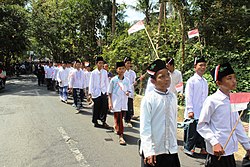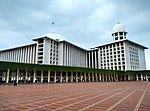Santri

InIndonesia,santriis a term for someone who followsIslamicreligious educationinpesantren(Islamicboarding schools). Santri usually stay in the place until their education is complete. After completing their study period, some of them will serve thepesantrenby becoming administrators. According to C.C. Berg, the term "santri" comes fromSanskritshastriwhich means "one who learnsHindu scriptures";it has the same root as the wordshastra(literature).[1][2]
Starting in 2015, October 22 is designated as the National Santri Day (Hari Santri Nasional) in Indonesia. The date refers to "jihadresolution "issued byHasyim Asy'ariofNahdlatul Ulamatoulamaand santri prior tothe national revolution.[3]
Geertz research
[edit]In a study by American sociologistClifford Geertz,the santri are people, particularly inJava,who practice a more orthodox version ofIslam,in contrast to the more syncreticabangan.
Geertz identified three main cultural streams (aliraninIndonesian) in Javanese society; namely, thesantri,abangan,andpriyayi.[4][5]Members of theSantriclass are more likely to be urban dwellers, and tend to be oriented to themosque,theQur'an,and perhaps to Islamic canon law (Sharia). In contrast, theabangantend to be from village backgrounds and absorb bothHinduand Muslim elements, forming a culture of animist and folk traditions, it is also claimed that this particular class originated fromSindhisailors, who had settled in Java.[4]Thesantriare sometimes referred to asPutihan(the white ones) as distinct from the 'red'abangan.Thepriyayistream are the traditional bureaucratic elite and were strongly driven by hierarchical Hindu-Javanese tradition. Initially court officials in pre-colonial kingdoms, the stream moved into thecolonial civil service,and then on to administrators of the modern Indonesian republic.[4]
Thesantriplayed a key role in Indonesian nationalist movements, and formed the strongest opposition toPresidentSuharto'sNew Orderarmy-based administration.[4]In contrast, thepriyayihave tended to follow the prevailing political wind; they supported Sukarno's overt nationalism, while during Suharto's subsequent presidency, they loyally voted for hisGolkarparty.[4]Poorerabanganareas became strongholds of theIndonesian Communist Party(PKI) in stark opposition to the orthodox Muslimsantri.The cultural divisions descended into bloody conflict in 1965/66 whensantriwere opposed to communists, many of whom were fromabanganstreams. An estimated500,000 alleged communists were killedduring thetransition to the New Order,and bitter political and social rivalries remain.[4]
See also
[edit]Notes
[edit]- ^Efendi, Ferry; Makhfudli (2009).Keperawatan Kesehatan Komunitas: Teori dan Praktik dalam Keperawatan.Jakarta: Salemba Medika. p. 313.ISBN9789793027944.Retrieved22 September2022.
- ^Raditya, Iswara N (21 October 2019)."Sejarah & Asal Usul Kata Santri: Berasal dari Bahasa Sanskerta?".tirto.id.Retrieved12 February2021.
- ^Harbani, Rahma Indina (22 October 2021)."Hari Santri Nasional 2021 Lahir dari Resolusi Jihad, Bagaimana Awalnya?".Detik.Retrieved22 September2022.
- ^abcdefMcDonald, Hamish (1980).Suharto's Indonesia.Melbourne: Fontana. pp. 9–10.ISBN0-00-635721-0.
- ^Geertz, Clifford (1960). "The Santri Variant".The Religion of Java(1976 p/b - Part Two ed.). Chicago: The University of Chicago Press. pp. 121–215.ISBN0-226-28510-3.
References
[edit]- Magnis-Suseno F (1981).Javanese Ethics and World-View: The Javanese Idea of the Good Life.Jakarta: PT Gramedia Pustaka Utama. pp. 15–18.ISBN979-605-406-X.
- Friend, Theodore.Indonesian Destinies.Cambridge, Massachusetts and London: Belknap Press, Harvard University Press.ISBN0-674-01137-6.

